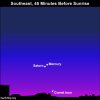If you get up early, be sure to gaze in the sunrise direction as darkness begins to give way to dawn on Monday, November 25 and Tuesday, November 26. Try looking around 80 to 60 minutes before sunrise. The planets Mercury and Saturn will be close together, less than one degree apart as seen from much of the world. At an arm’s length away, your little finger will probably cover both planets. They’ll appear in the same binocular field of view. Comet ISON is also nearby, but will be difficult to see.
The close conjunction of Mercury and Saturn isn’t the only show going on at this early morning hour. Look for the moon and then spot the nearby star Regulus in the predawn and dawn sky on November 25.

Mercury and Saturn will easily fit within a single binocular field from anywhere worldwide. Or, if you have a low-powered telescope, you might even see both worlds occupying the same telescopic field of view. By the way, the star shining close to Mercury and Saturn is Zubenelgenubi, the alpha star of the constellation Libra the Scales.
Watch closely over the next few mornings. You’ll see Mercury, the brighter of these two worlds, sinking toward the sunrise day by day while Saturn is climbing upward. As seen from North America, Mercury shines above Saturn on November 25 but below the ringed planet on November 26.
Bottom line: For the next several mornings – at dawn on November 25 and 26, 2013 – the planets Mercury and Saturn, plus the star Zubenelgenubi, all appear in a single binocular field of view. They’ll be very low in the sky, in the sunrise direction.
The close conjunction of Mercury and Saturn isn’t the only show going on at this early morning hour. Look for the moon and then spot the nearby star Regulus in the predawn and dawn sky on November 25.

Mercury and Saturn will easily fit within a single binocular field from anywhere worldwide. Or, if you have a low-powered telescope, you might even see both worlds occupying the same telescopic field of view. By the way, the star shining close to Mercury and Saturn is Zubenelgenubi, the alpha star of the constellation Libra the Scales.
Watch closely over the next few mornings. You’ll see Mercury, the brighter of these two worlds, sinking toward the sunrise day by day while Saturn is climbing upward. As seen from North America, Mercury shines above Saturn on November 25 but below the ringed planet on November 26.
Bottom line: For the next several mornings – at dawn on November 25 and 26, 2013 – the planets Mercury and Saturn, plus the star Zubenelgenubi, all appear in a single binocular field of view. They’ll be very low in the sky, in the sunrise direction.
